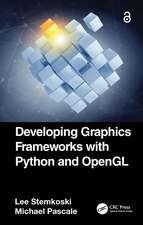Information Design for the Common Good: Human-centric Approaches to Contemporary Design Challenges
Autor Courtney Marcheseen Limba Engleză Paperback – 8 sep 2021
| Toate formatele și edițiile | Preț | Express |
|---|---|---|
| Paperback (1) | 132.75 lei 22-36 zile | +26.61 lei 6-12 zile |
| Bloomsbury Publishing – 8 sep 2021 | 132.75 lei 22-36 zile | +26.61 lei 6-12 zile |
| Hardback (1) | 448.04 lei 22-36 zile | |
| Bloomsbury Publishing – 8 sep 2021 | 448.04 lei 22-36 zile |
Preț: 132.75 lei
Preț vechi: 178.85 lei
-26% Nou
Puncte Express: 199
Preț estimativ în valută:
25.41€ • 26.43$ • 20.97£
25.41€ • 26.43$ • 20.97£
Carte disponibilă
Livrare economică 24 martie-07 aprilie
Livrare express 08-14 martie pentru 36.60 lei
Preluare comenzi: 021 569.72.76
Specificații
ISBN-13: 9781350117266
ISBN-10: 1350117269
Pagini: 216
Ilustrații: 200 colour illus
Dimensiuni: 156 x 234 x 13 mm
Greutate: 0.46 kg
Editura: Bloomsbury Publishing
Colecția Bloomsbury Visual Arts
Locul publicării:London, United Kingdom
ISBN-10: 1350117269
Pagini: 216
Ilustrații: 200 colour illus
Dimensiuni: 156 x 234 x 13 mm
Greutate: 0.46 kg
Editura: Bloomsbury Publishing
Colecția Bloomsbury Visual Arts
Locul publicării:London, United Kingdom
Caracteristici
A practical and user-friendly approach that allows the reader to see how to put into practice the principles of working morally and with responsibility when designing information visualizations
Notă biografică
Courtney Marchese is a Connecticut-based graphic designer and educator. She received her B.A. in Interactive Digital Design from Quinnipiac University in Hamden, Connecticut, before earning her M.F.A. in Graphic Design at SCAD in Savannah, Georgia. Courtney now teaches at her alma mater, Quinnipiac University.
Cuprins
Chapter 1 - The Roots of Data-Driven DesignInformation Design vs Data VisualizationHistorical OverviewCase Study: Harry Stevens, Washington PostEvolution of FormCase Study: Jason Treat, National Geographic, World PlasticsMethods and ToolsChapter 2 - Social Good and EmpathySocial GoodHistory of Social DesignEmpathyCase Study: Juanita Londono, Impact Over FormHistory of EmpathyCase Study: Jan Willem Tulp (Tulp Interactive), World Water AtlasApplied Empathy and HumanizationMethodsChapter 3 - Collaboration and the Process of Data-Driven DesignThe Evolution of Design Processes and Data ExplorationCase Study: Bryan Christie Design, National Geographic, Katie's New FaceCase Study: Dino Citraro, Periscopic, Pacific Salmon ExplorerCollaborative Opportunity Starts EarlyCase Study: Sophia Aliferi and Courtney Marchese, Fifth WaveChapter 4 - Truth and Integrity in Data PresentationData LiteracyBest Practices of Honest DataCarbon Footprint, David McCandlessRhetoric and PersuasionAvoiding Misleading DataCase Study: WHO, Violence InfoMapsCase Study: Pablo Robles, South China Morning PostMethods - Finding and Cleaning DataChapter 5 - Crafting a Meaningful NarrativeExploratory to Explanatory DataFunctions and Goals of Storytelling with DataCase Study: Martin Krzywinski, The Many Paths of COVID-19 SpreadCase Study: Pentagram, Covid-19 Press Briefing GraphicsPersuasion and MemorabilityNarrative Structure and PlotCase Study: Dawn Kai, Reuters, Life in the CampsCase Study: Werner Helmich, GOV | DNAStoryboardingChapter 6 - Visual CuesIntroductionPerception and GestaltMarks, Type, Color, and Other Graphic DetailsCase Study: Shin-Yun Chiang, Houston Flooding and PovertyCase Study: Sarthak Kathuria, Georgia PeachW.E.B. Du Bois and Black AmericaThe Influence of IsotypeCase Study: Institute for Disease Modeling, Malaria LifecycleMethods and Tools - Making Better Icon SystemsChapter 7 - Measuring Impact, with Laura Willis, PhDCase Study: Nadieh Bremer, The GuardianGoals and ReachResearch MethodsEvaluation DesignEvaluation MaterialsCommon Mistakes and Key ConsiderationsCase Study: Giorgia Lupi, BruisesConclusionImage CreditsIndex























